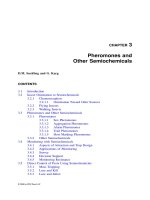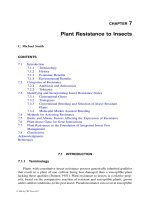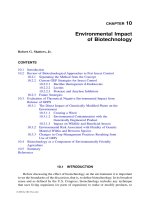Environmental Toxicology : Biological and Health Effects of Pollutants - Chapter 3 ppsx
Bạn đang xem bản rút gọn của tài liệu. Xem và tải ngay bản đầy đủ của tài liệu tại đây (719.56 KB, 13 trang )
Chapter 3
Occurrence of Toxicants
3.1 INTRODUCTION
A large number of pollutants are present in the environment, often in very
large quantities. They arise from many sources and exposure to these
pollutants may occur through a range of routes. For example, the ambient
air in urban areas may contain sulfur dioxide (SO
2
), carbon monoxide (CO),
and nitrogen oxides (NO
x
), as well as smoke and suspended particles
containing metals and hydrocarbons produced mainly from coal or heavy-oil
combustion by industries, power plants, and some households. Several
pollutants are also found in the indoor environment. Some examples include
CO arising from incomplete combustion of fossil fuels and tobacco smoke, lead
(Pb) from paint used in old houses, and formaldehyde from insulation and
wood preservatives and adhesives.
This chapter will focus on where and how certain pollutants may occur in
the environment. This is followed by a brief review of major pollution episodes
and disasters that have occurred in recent decades.
3.2 VISIBLE SMOKE OR SMOG
The presence of visible smoke or smog is a manifestation of air pollution.
Smoke is composed of the gaseous products of burning carbonaceous materials
made visible by the presence of small particles of carbon. The brownish to
blackish materials emitted from the stack of an inadequately controlled coal-
burning industrial plant, or from the chimney of a wood-burning home, are
examples. Wood burning has become a common practice in many American
homes, especially in winter. Burning wood in a well-insulated home, however,
can lead to discomfort associ ated with indoor pollution. The problem
associated with indoor air pollution is particularly serious in many villages
in southern China, where indoor combustion of coal for cooking meals or
drying vegetables is common.
Smog, on the other hand, is a natural fog made heavier and darker by
smoke and chemical fumes. Smog is formed mainly as a result of photo-
chemical reactions. In the presence of UV rays in sunlight, nitrogen dioxide
(NO
2
) is broken down into nitric oxide (NO) and atomic oxygen. Atomic
oxygen can then react with molecular oxygen in the air to form ozone (O
3
). A
large number of chemical reactions may also occur among hydrocarbons or
between hydrocarbons and NO, NO
2
,O
3
, or other chemical species in the
[16:54 26/8/04 P:/CRC PRESS/4365 MING-HO.751 (1670)/4365-003.3d] Ref: 4365 MING-HO YU Chap-003 Page: 31 31-44
# 2005byCRCPressLLC
atmosphere, leading to the formation of numerous chemical species. Both NO
and NO
2
are called primary air pollutant s, as they are formed at the source of
combustion or emission. Compounds produced from chemical reactions that
occur after the primary pollutants are emitted into the atmosphere are called
secondary pollutants. Examples of secondary pollutants include O
3
, peroxyacyl
nitrate (PAN), and some aldehydes and ketones (NO
2
can also be included as a
secondary pollutant – see Chapter 8). Smog is composed of both primary and
secondary air pollutants; it contai ns NO
2
,O
3
, and other photochemical
oxidants and a large number of other chemical species.
Both smoke and smog cause reduction in visibility because light is scattered
by the surfaces of airborne particles. They can both cause adverse effects on
vegetation, animals, and humans.
Although Los Angeles is widely known for its smog, many large cities are
suffering increasingly from similar problems. This is particularly true in some
less-industrialized countries that have experienced unprecedented growth in
recent decades. This growth has led to the emergence of a number of
megacities, with populations of 10 million or more people. Global ly, many
rapidly growing cities are also known to be among the most polluted in the
world. Residents in those cities are overwhelmed by environmental problems,
especially those related to air pollution. Examples of such countries include
China, India, Mexico, and Thailand. The megacities in these countries are
experiencing concentrations of a number of air pollutants well above the levels
recommended by the World Health Organization (WHO). For example,
Mexico City, with an estimated population of more than 20 million, has been
experiencing serious air pollution problems.
Shen-Chen, a rapidly growing city in southern China, is another example
with air pollution problems, even though its population is only about one
million. In the morning, visibility is often good: it is possible to see the green
mountain to the southwest of the city, but in the afternoon smog often
develops, resulting in poor visibility. Figu re 3.1a and Figure 3.1b show
contrasting views of the city.
3.3 OFFENSIVE ODORS
Malodors are often the first manifestation of air pollution. They are present in
natural air, households, farms, sewage treatment plants, solid waste disposal
sites, and in many industrial areas. Natural air may contain odors arising from
a variety of sources. Decomposition of protein-containing organic matter
derived from vegetation and animals can contribute to odors in the air.
Odors from cooking foods, such as fish, meat, and poultry, can contribute
greatly to the odors sensed in a household. Fresh paints, fresh carpets,
furniture polish, cleaning fluid, wood-burning fireplaces, and deodorants are
some other examples. Cigarette smoking can also be an important cause of
odors in public places, restaurants or households.
32 Environmental Toxicology
[16:54 26/8/04 P:/CRC PRESS/4365 MING-HO.751 (1670)/4365-003.3d] Ref: 4365 MING-HO YU Chap-003 Page: 32 31-44
# 2005byCRCPressLLC
Offensive odors may be detected in areas adjacent to industries, and vary
according to the type of industries involved. Some examples of industrial
sources of malodors include:
pulp mills, which release hydrogen sulfide (H
2
S), causing ‘‘rotten-egg’’ type
odors
oil refineries, due to H
2
S and mercaptans
some chemical plants, due mainly to use of aniline or organic solvents
food processing plants
iron and metal smelters, which emit acidic smells
phosphate fertilizer manufacturing plants
Occurrence of Toxicants 33
[16:54 26/8/04 P:/CRC PRESS/4365 MING-HO.751 (1670)/4365-003.3d] Ref: 4365 MING-HO YU Chap-003 Page: 33 31-44
FIGURE 3.1 Smog development in Shen-Chen, China: (a) clear morning, and (b) afternoon smog.
# 2005byCRCPressLLC
3.4 AGRICULTURAL DAMAGE
Agricultural damage constitutes the major damage to vegetation caused by air
pollution (discussed in more detail in Chapter 8). A widely known example is
the destruction of forests by acid rain. Ample evidence exists attesting to this
phenomenon in the U.S., Canada, and in some European countries. Acid rain
causes changes in plant growth that are manifested by stunted growth, lack of
vigor, reduced productivity, and early senescence of leaves. Air pollutants such
as NO
2
,O
3
, PAN and fluoride can also cause serious injuries to plants. Man y
fruit trees and vegetables are particularly sensitive to these pollutants.
Assessment of the immediate and long-term economic effects of air
pollution on agriculture is difficult because of the many variables involved.
However, available information indica tes that the cost due to decreased crop
yields is staggering. For instance, the 1986 estimated losses to producers caused
by O
3
alone were $1 billion to $5 billion.
1
The estimated cost of damage caused
by acid rain to 32 major crops in the U.S. was $50 billion.
Injuries to plants by air pollution are often manifested by such symptoms as
chlorosis and necrosis. Chlorosis is the fading of natural green color, or
yellowing, of plant leaves, and is due to the destruction of chlorophyll or
interference with chlorophyll biosynthesis. Necrosis refers to localized or
general death of plant tissue and is often characterized by brownish or black
discoloration.
3.5 INTOXICATION OF ANIMALS
Many published reports reveal adverse effects in animals that have been
exposed to gaseous and particulate forms of air pollutants emitted from
industrial facilities. Examples of these facilities include phosphate fertilizer
manufacturing plants, aluminum manufacturing plants, iron and other types of
smelters, and coal-burning power plants. As is widely known, a large number
of air pollutants are emitted from these industrial sources. Animals residing in
areas adjacent to these industrial sources are exposed to the pollutants emitted
from these sources, resulting in injuries. This is explored further in subsequent
chapters.
Similarly, reports of the injuries of fish and wildlife caused by water
pollution also abound. Many diseased sea mammals have been washed ashore
in different parts of the world in recent years, apparently due to damaged
immune systems su bsequent to exposure to waterborne toxicants. In the U.S.,
it is estimated that more than one million waterfowls are killed every year
following the ingestion of spent lead pellets left after hunting.
A new type of environmental disease has appeared recently and attracted
the attention of many scientists. Beginning in about 1991, biologists noted
dramatic declines in amphibian populations and increases in deformities in
frogs, with no apparent causes, in remote, high-altitude areas of western U.S.,
Puerto Rico, Costa Rica, Panama, Colombia, and Australia. The declines
34 Environmental Toxicology
[16:54 26/8/04 P:/CRC PRESS/4365 MING-HO.751 (1670)/4365-003.3d] Ref: 4365 MING-HO YU Chap-003 Page: 34 31-44
# 2005byCRCPressLLC
represented a sharp departure from previous years, when amphibian popula-
tions had crashed only from habitat destruction or the introduction of exotic
predator species. Scientists fear that many species of amphibians that have
been around for 350 million years will not survive the 21st century. They view
these population losses as an indication that there may be something seriously
wrong with the environment. Some scientists suspect that infections, and the
effects of synthetic organic compounds (such as pesticides), metallic con-
taminants, acid precipitation, UV radiation, and increa sed temperatures may
be responsible for the phenomenon. So far, however, there is no conclusive
evidence that any of these is responsible for the mysterious declines. Some
scientists believe that several factors may be acting synergistically to produce
the rapid die-offs.
2
3.6 INJURIES TO HUMANS
Many individuals in numerous countries have suffered injuries resulting from
exposure to high levels of airborne or waterborne pollutants. Exposure to high
levels of air pollutants results in various physiological changes, leading to
health problems. Air pollutants, such as SO
2
,O
3
and other oxidants, and
particulate matter, have been regarded as being responsible, solely or in
combination, for causing coughing, degeneration of the lining of the throat,
pulmonary disease, and heart failure. Some of the injuries result in permanent
disability, while others are fatal. Historically, such human injuries occurred
only in certain occupations, but in recent years, injuries or deaths have
occurred as results of non-occupation-related factors.
Studies show that over the past tw o decades there has been a startling rise
in the prevalence of asthma among children and young adults. This trend
persists, mostly in affluent countries.
3
In many of the countries where asthma is
common, its prevalence has jumped nearly 50% in 10 years. Rates of
hospitalization for asthma are also rising in these countries. For example,
asthma mortality among persons of the age group 5 to 34 years rose more than
40% between the mid-1970s and mid-1980s in most countries studied.
4
Although the reason for this trend is not known, many scientists consider it
to be associated with environmental factors.
Individuals exposed to toxicants may suffer from various signs and
symptoms without knowing the cause at the time of exposure. Furthermore,
symptoms may not be manifested immediately following exposure. With
cancer, it often takes 15 years or more for symptoms to appear. For example,
many of New York’s shipyard workers who developed diseases after exposure
during the 1940s to asbestos were not diagnosed until 15 to 30 years later.
Other examples include Minamata disease and itai-itai-byo, described in
Chapter 2. A further example is ‘‘yu-sho’’ or ‘‘oil disease,’’ which occurred in
Japan as a result of consuming rice oil that was highly contaminated by
polychlorinated biphenyls (PCBs).
Occurrence of Toxicants 35
[16:54 26/8/04 P:/CRC PRESS/4365 MING-HO.751 (1670)/4365-003.3d] Ref: 4365 MING-HO YU Chap-003 Page: 35 31-44
# 2005byCRCPressLLC
Human exposure to pesticides can occur directly, especially for agricultural
workers and their families. Individuals residing in areas near farms where
pesticides are heavily applied may also be directly exposed. Indirect exposure
can also occur, e.g., when pesticide residues on food or contaminated fish are
ingested. Some synthetic organic pesticides are slow to degrade and persist in
the environment for years. Accumulation of various types of pesticides in
human tissues can therefore occur and result in health problems.
It is clear that an enormous effort has been made in the U.S. by
government, industries, and the public in an attempt to reduce environmental
pollution. Such effort has led to a number of encouraging results. According to
the U.S. Environmental Protection Agency’s 1994 annual assessment of urban
air pollution, air quality in the U.S. was improving; however 43 metropolitan
regions, home to nearly 100 million Americans, had O
3
levels at more than
0.12 ppm, exceeding federal health standards. In the Los Angeles Basin, in
particular, the pollution is so bad that it was given a deadline of 2010 to meet
the federal standards.
3.7 ACUTE AND CHRONIC EFFECTS
3.7.1 I
NTRODUCTION
In studying the health effects of toxicants on living organisms, researchers often
identify effects as acute or chronic. An acute effect refers to that manifested by
severe injuries or even death of an organism, and is characterized by exposure
to high concentrations of a toxicant or toxicants for a short period of time. A
chronic effect is characterized by a long-term or recurrent exposure to relatively
low concentrations of toxicants. Signs and symptoms vary depending on the
types of toxicants, their concentrations, and species of exposed organisms.
3.7.2 A
CUTE EFFECTS
A number of acute pollution episodes have occurred in different parts of the
world since 1930. A brief review of several major ones follows, and readers are
referred to detailed reviews published elsewhere.
5
3.7.2.1 Meuse Valley, Belgium, 1930
This episode occurred on December 1, 1930 in Meuse Valley, Belgium, where a
large number of industrial plants were located. A thermal inversion caused
pollutants, such as SO
2
, sulfuric acid mist, and particulates, emitted from these
plants, to be trapped in the valley. Many people became ill with respiratory
discomforts. Reported casualties include 60 human deaths and some deaths in
cattle.
36 Environmental Toxicology
[16:54 26/8/04 P:/CRC PRESS/4365 MING-HO.751 (1670)/4365-003.3d] Ref: 4365 MING-HO YU Chap-003 Page: 36 31-44
# 2005byCRCPressLLC
3.7.2.2 Donora, Pennsylvania, U.S., 1948
This episode took place on October 26, 1948, and was also due to thermal
inversion and foggy weather, which affected a wide area. Many industries,
including a large steel mill, a zinc-production plant, and a sulfuric-acid plant,
were located in this small industrial city. Nearly half of the population of
14,000 became ill, with coughing being the most prevalent symptom. High
levels of SO
2
and particulate matter were the suspected cause of the suffering.
This episode resulted in 20 human deaths.
3.7.2.3 Poza Rica, Mexico, 1950
The incident that occurred in the city of Poza Rica, Mexico, in the early
morning of November 24, 1950, was caused by the accidental release of H
2
S
from a natural gas plant. At the time of the accident, most of the nearby
residents were still in bed or had just gotten up. Many were quickly affected
with symptoms of respiratory distress and central nervou s system damage.
Twenty-two people died and more than 300 were hospitalized.
3.7.2.4 London, England, 1952
This is the most widely known air pollution episode. It occurred during
December 5 through 8, 1952, and was the result of fog and thermal inversion.
Many people suffered from shortne ss of breath. Cyanosis, some fever, and
excess fluid in the lungs were reported in many patients. High levels of SO
2
,
fluoride, and smoke were recorded in the air. According to municipal statistics,
approximately 4000 excess deaths occurred. The figure obtained was the
difference between the average number of deaths for the same period between
1947 and 1951 and the number of deaths that occurred during the episode
(Figure 3.2). Most of those affected were in the older age groups, and generally
had disease of the heart or lungs prior to the pollution episode.
3.7.2.5 New York, U.S., 1953
This episode occurred from November 18 to 22, 1953, as a result of air
stagnation and the presence of a high level of SO
2
and led to several thousand
excess deaths.
3.7.2.6 Los Angeles, California, U.S., 1954
Unlike those events mentioned above, the cause of this episode was smog
formation and the accumulation of high levels of photochemical oxidants, such
as O
3
and PAN. Excess deaths totaling 247 per day in the 65 to 70 year age
group were among the observed consequences.
Occurrence of Toxicants 37
[16:54 26/8/04 P:/CRC PRESS/4365 MING-HO.751 (1670)/4365-003.3d] Ref: 4365 MING-HO YU Chap-003 Page: 37 31-44
# 2005byCRCPressLLC
3.7.2.7 New Orleans, Louisiana, U.S., 1955
This episode was marked by a sharp increase in the incidence of asthma among
the residents of the city. The normal frequency of visits to a local hospital was
reported to be an average of 25 per day; but during the episode period it was
200 per day. The suspected cause was dust from flour mills.
3.7.2.8 Worldwide Episode, 1962
This air pollution episode lasted from November 27 to December 10, 1962, and
involved the eastern part of the U.S.; London, England; Rotterdam, The
Netherlands; Osaka , Japan; Frankfurt, Germany; Paris, France; and Prague,
Czechoslovakia. Patients in the U.S. suffered upper respiratory symptoms.
There were 700 excess deaths in London, and 60 in Osaka.
3.7.2.9 Tokyo, Japan, 1970
This episode occurred in Tokyo, Japan, on July 18, 1970, and was due to high
levels of oxidants and SO
2
in the atmosphere. More than 6000 people
complained of severe eye irritation and sore throat. Figure 3.3 shows a smoggy
day in Tokyo in 1972, with Tokyo Tower barely visible. (Much improvement in
Tokyo’s air quality has since been made. Many visitors are impressed with the
generally favorable air quality, considering that the city’s population is more
than 15 million.)
38 Environmental Toxicology
[16:54 26/8/04 P:/CRC PRESS/4365 MING-HO.751 (1670)/4365-003.3d] Ref: 4365 MING-HO YU Chap-003 Page: 38 31-44
FIGURE 3.2 Excess deaths in Greater London, England, during the air pollution episode of
December 5 to 8, 1952.
# 2005byCRCPressLLC
3.7.2.10 Bhopal, India, 1984
The worst industrial accident in history occurred in the city of Bhopal, India
(Figure 3.4) on the morning of December 3, 1984. Forty tons of the highly
toxic gas methyl isocyanate (MIC) (CH
3
ÀN¼C¼O) leaked from a pesticide
plant located in Bhopal and diffused into densely populated adjacent
neighborhoods. At least 4000 people were killed, and more than 150,000
injured. It was observed that the lung was the main target organ of MIC. A
hospital report released three days after the exposure showed the occurrence of
interstitial edema, alveolar and interstitial edema, and emphysema among the
victims treated.
6
The large number of deaths and injuries (resulting in many
permanently disabled), made the accident the greatest acute chemical disaster
ever.
7
3.7.2.11 Chernobyl, USSR, 1986
By far the gravest disaster in the history of commercial atomic power occurred
on April 26, 1986, at Chernobyl in Ukraine (Figure 3.5), then a state of the
Soviet Union. The No. 4 reactor of the Chernobyl nuclear power station partly
melted down and exploded, killing 32 people in the immediate area and causing
237 cases of acute radiation sickness.
8
The explosion sent a devastating cloud
of radiation across a wide swath of Europe. Radioactive forms of iodine,
cesium, strontium, and plutonium were released into the atmosphere and
deposited throughout the northern hemisphere. The 30 km zone surrounding
the station, from whi ch 115,000 people were evacuated, received especially high
exposure: for the people from this zone the risk of spontaneous leukemia was
Occurrence of Toxicants 39
[16:54 26/8/04 P:/CRC PRESS/4365 MING-HO.751 (1670)/4365-003.3d] Ref: 4365 MING-HO YU Chap-003 Page: 39 31-44
FIGURE 3.3 Smog in Tokyo in 1972.
# 2005byCRCPressLLC
estimated to be double for the next decade, and some genetic disorders may
appear in individuals who were exposed in utero. The total radioactivity of the
material released from the reactor was estimated to be 200 times that of the
combined releases from the atomic bombs dropped on Hiroshima and
Nagasaki, according to a 1995 WHO report.
The accident exposed millions of people, notably in Belarus, Russia, and
the Ukraine, to varying doses of radiation. According to the Organization for
Economic Cooperation and Development and the Nuclear Energy Agency, 20
radionuclides were released into the atmosphere. They included iodine-131
with a half-life of 8 days; cesium-134 and cesium-137 with half-lives of 2 days
and 30 years, respectively; and several plutonium isotopes with half-lives
ranging from 13 to 24,000 years. Subsequent studies indicated a dramatic
increase in the incidence of thyroid cancer in children, mainly in Belarus and
the Ukraine, but also to a lesser extent in Russia.
9
40 Environmental Toxicology
[16:54 26/8/04 P:/CRC PRESS/4365 MING-HO.751 (1670)/4365-003.3d] Ref: 4365 MING-HO YU Chap-003 Page: 40 31-44
FIGURE 3.4 Location of Bhopal, India.
# 2005byCRCPressLLC
3.7.2.12 Prince William Sound, Alaska, U.S., 1989
Crude oil from the North Slope oilfields in Alaska is carried by pipeline to the
port of Valdez and then shipped by tanker to the west coast of the U.S. On
March 24, 1989, a huge tanker, named Exxon Valdez, went off course in a
16 km-wide channel in Prince William Sound, near Valdez, a harbor town of
4200. The tanker struck a reef, causing the worst ever oil spill in U.S. waters.
Eleven million gallons of crude oil escaped, and coated more than 2000 km of
shoreline and killing an estimat ed 250,000 seabirds, 2800 seaotters, 300 harbor
seals, 250 bald eagles, as many as 22 killer whales,
10
and countless other marine
mammals and fish. The spill also injured an unknown number of salmon and
herring eggs and larvae.
While many scientists believed that affected areas had recovered within a
decade after the disaster, a new study by Short et al.
11
at the Alaska Fisheries
Science Center, NOAA, made an alarming observation. According to the
study, oil was found on 78 of 91 beaches randomly selected. The cumulative
area of beach contaminated by surface or subsurface oil was estimated at 11.3
ha, and the mass of remaining subsurface oil was about 0.2% of the original
oil. The results of their study suggest that the toxicity stemming from the oil,
primarily from polyaromatic hydrocarbons (PAHs), continues to affect the
recovery of some sea animals in places where the oil is most persistent.
11
3.7.2.13 Gas Well Accident, Gaoqiao, China, 2003
On December 23, 2003, a leak occurred from a well in a natural-gas field at
Gaoqiao, a town in southwest China. The leak spewed out toxic fumes,
containing H
2
S, which killed at least 191 people and forced 31,000 people living
Occurrence of Toxicants 41
[16:54 26/8/04 P:/CRC PRESS/4365 MING-HO.751 (1670)/4365-003.3d] Ref: 4365 MING-HO YU Chap-003 Page: 41 31-44
FIGURE 3.5 Location of Chernobyl, Ukraine.
# 2005byCRCPressLLC
within three miles of the gas field to flee their homes. The cause of the disaster
reportedly involved a drilling mishap, which broke open a gas well.
3.7.3 C
HRONIC EFFECTS
Chronic intoxication is more common than acute episodes of poisoning.
Numerous reports have been published relating chronic effects of both air and
water pollution on living systems. Long-term exposure to relatively low
concentrations of air pollutants, such as SO
2
, smoke, and heavy metals (e.g.,
lead, cadmium, and mercury), may eventually lead to injuries in plants,
animals, or humans. The Minamata Bay incident and itai-itai-byo mentioned
above are examples of chronic effects related to water pollution. More detailed
information is provided in later chapters.
In plants, chronic effects are manifested as impaired growth and develop-
ment, decreased respiration, chlorosis, necrosis, and other symptoms.
Similarly, chronic effects in animals are reflected in retarded growth, increased
susceptibility to other environmental stresses, and a variety of adverse health
effects, including shorter life spans.
In humans, the health effects of air pollution exposure may occur over a
long period of time. A prolonged exposure to air pollutants such as NO
2
and
O
3
, for instance, may lead to chronic bronchitis and emphysema. In the U. K.,
the combination of SO
2
and smoke pollution is thought to have synergistic
effects with cigarette smoking, causing degenerative diseases.
Results from occupational studies strongly suggest a close association
between air pollution exposure and respiratory cancer. For example, inhalation
of toxic materials, such as arsenic, asbestos, chromium, soot, mustard gas, and
radon, under occupational conditions has been related to lung cancer.
12
In an
effort to assess the association between air pollution and daily outpatient
hospital visits, Xu et al.
13
collected data on nonsurgery outpatient visits at a
community-based hospital in Beijing, China, and on atmospheric SO
2
and total
suspended particle (TSP) levels. Analysis of the data showed increases of 20%
and 17% in nonsurgery outpatient visits to the hospital, in association with
increases in SO
2
and TSP levels, respectively. These observations led to the
conclusion that the existing air-pollution levels in Beijing are associated with
adverse health effects.
Similar observations were made in Hong Kong. Researchers studied the
levels of SO
2
,NO
2
,O
3
, and atmospheric particulate matter less than 10 mm
in diameter (PM
10
) and found a significant association with daily hospital
admissions for cardiovascular and respiratory diseases, both combined and
separately.
14
Furthermore, the effects of the pollut ants on circulatory and
respiratory diseases were stronger for older age groups, with significant excess
of 5 to 10% in those aged 65 or over. Both NO
2
and O
3
were strongly
associated with hospital deaths from cardiovascular and respiratory dis-
eases.
15
42 Environmental Toxicology
[16:54 26/8/04 P:/CRC PRESS/4365 MING-HO.751 (1670)/4365-003.3d] Ref: 4365 MING-HO YU Chap-003 Page: 42 31-44
# 2005byCRCPressLLC
3.8 REFERENCES
1. Cerceo, E., Acid precipitation in southern New Jersey, Amer. Lab., July, 1987,
24.
2. Hileman, B., Amphibian declines remain a mystery, C&EN, June 15, 1998, 20.
3. Thomas, A., Platts-Mills, E. and Carter, M.C., Asthma and indoor exposure to
allergens, New Engl. J. Med., 336, 1384, 1997.
4. Sears, M.R., Worldwide trends in asthma mortality, Bull. Int. Union Tuber.
Lung Dis., 66, 80, 1991.
5. Goldsmith, J. R. and Friberg, L. T., Effects of air pollution on human health,
in Stern, A.C., Ed., Air Pollution, Vol. II, 2nd ed., Academic Press, New York,
1977, p.469.
6. Mehta, P.S. et al. Bhopal tragedy’s health effects – A review of methyl
isocyanate toxicity, J. Am. Med. Assoc., 264, 2781, 1990.
7. Brown, H.S., Lessons from Bhopal, C &EN, Oct. 10, 1994, 38.
8. Anspauch, L.R., Catlin, R.J. and Goldman, M., The global impact of the
Chernobyl Reactor Accident, Science, 242, 1513, 1988.
9. Freemantle, M., Ten years after Chernobyl – Consequences are still emerging,
C&EN, April, 29, 1996, 18.
10. Christen, K., Slow recovery after Exxon Valdez oil spill, Environ. Sci. Technol.,
April 1, 1999, 148.
11. Short, J.W. et al., Estimate of oil persisting on the beaches of Prince William
Sound 12 years after the Exxon Valdez oil spill, Environ. Sci. Technol ., 38, 19,
2004.
12. Goldsmith, J.R. and Friberg, L.T., Effects of air pollution on human health, in
Stern, A.C., Ed., Air Pollution, Academic Press, New York, 1977, p.561.
13. Xu, X. et al., Association of air pollution hospital outpatient visits in Beijing,
Arch. Environ. Health, 50, 214, 1995.
14. Wong, C. M. et al., Coronary artery disease varies seasonably in subtropics,
Br. Med. J., 319, 1004, 1996.
15. Wong, C. M. et al., Effect of air pollution on daily mortality in Hong Kong,
Environ. Health Persp., 109, 335, 2001.
3.9 REVIEW QUESTIONS
1. What are the differences between acute and chronic injuries?
2. What is chlorosis? How does it occur?
3. What is meant by ‘‘excess deaths’’?
4. Most of the victims of air pollution episodes are older people or those with
prior illnesses. What are the possible reasons for this?
5. What are the differences between a primary pollutant and a secondary
pollutant?
6. How is air pollution associated with hospital admissions?
7. Explain the following episodes:
a) London, U.K., 1952
b) Bhopal, India, 1984
c) Chernobyl, USSR, 1986
d) Alaska, U.S., 1989
Occurrence of Toxicants 43
[16:54 26/8/04 P:/CRC PRESS/4365 MING-HO.751 (1670)/4365-003.3d] Ref: 4365 MING-HO YU Chap-003 Page: 43 31-44
# 2005byCRCPressLLC









